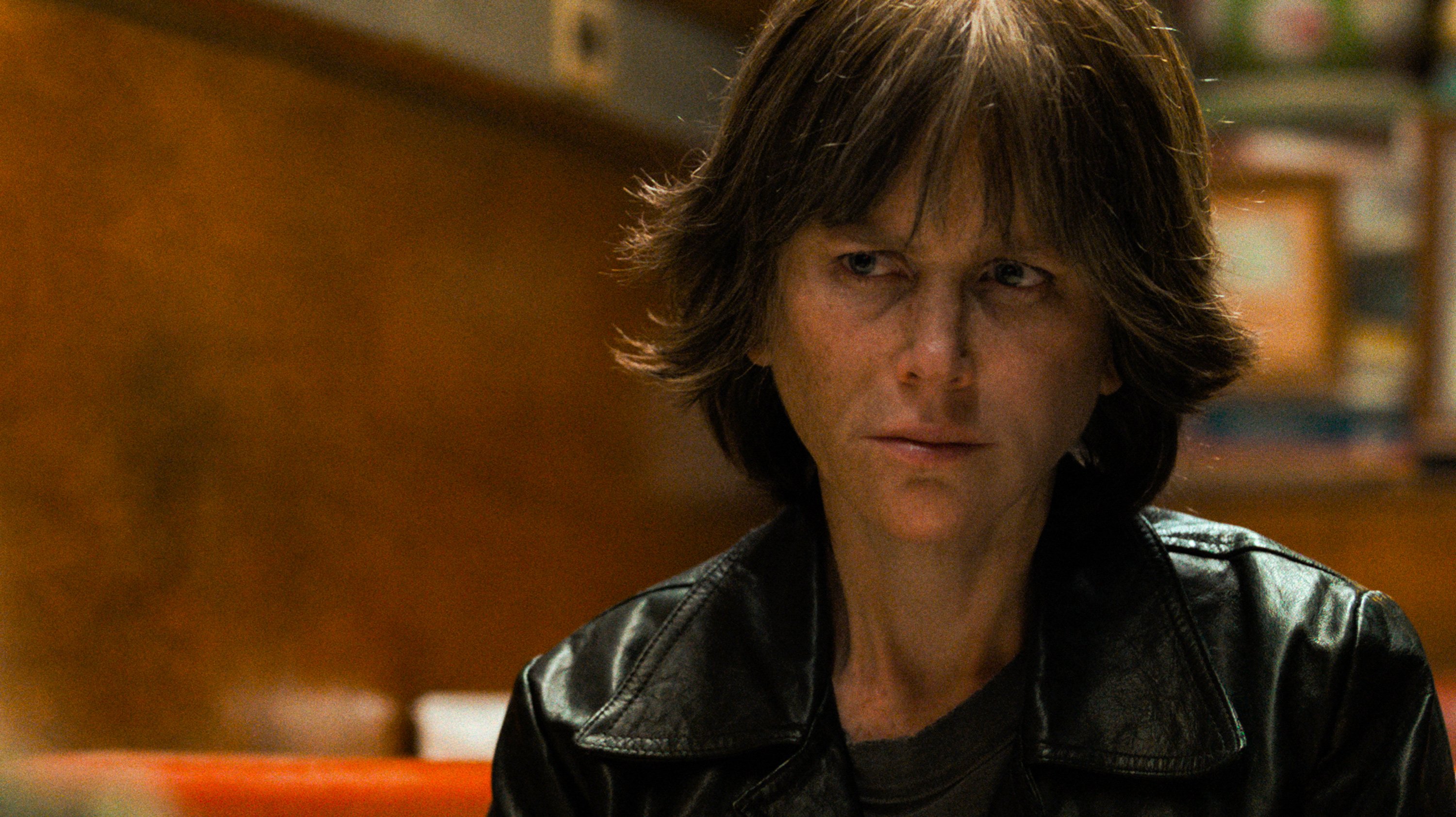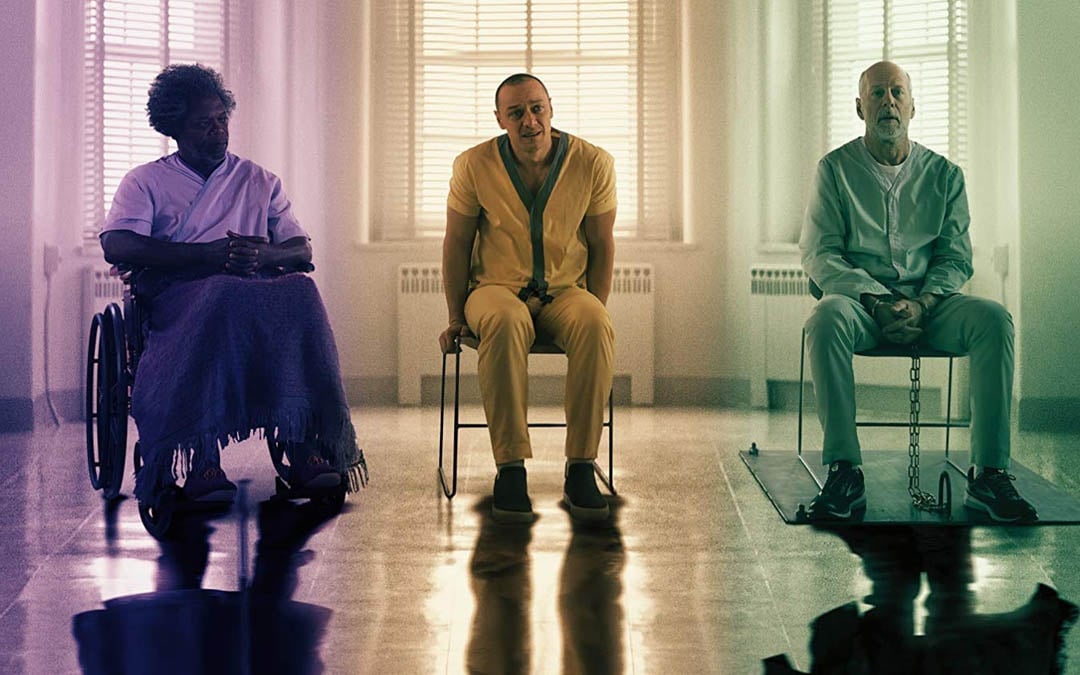All the Write Moves: Glass
February 5, 2019
M. Night Shyamalan, modern king of the twist ending, outdid himself with the final scene of Split (2016) — his surprise hit about a serial killer with multiple personalities — by connecting the picture to Unbreakable (2000), his cult-favorite thriller about an ordinary man who becomes a superhero.
Now Shyamalan completes the storytelling he started in those pictures with Glass.
In the new film, two characters from Unbreakable — hero David Dunn (Bruce Willis) and villain Mr. Glass (Samuel L. Jackson) — find themselves in the same psychiatric hospital as Kevin Wendell Crumb (James McAvoy), the killer from Split.
Shyamalan took on a set of complex writing tasks while crafting Glass; not only did he set out to resolve storylines from two movies, but also craft a thriller that works alone. While it is important to note critical reception of Glass has been as chilly as box-office reception has been warm, exploring the ways Shyamalan soared and stumbled while constructing the story of Glass is useful for students of his distinctive work.
Take Your Time
Shyamalan takes his time with camera moves, dialogue, plot revelations, even the pacing of individual scenes. Generally speaking, the goal of this technique is to create a sense of dread. In some instances, dread comes from knowing something unexpected — frightening, possibly — might arrive; a monster, a secret, whatever. In other instances, dread forms because Shyamalan makes us wait for what we know is coming.
It’s giving nothing away to say that several scenes in Glass feature Kevin attacking victims. In one such scene, which takes place in a hallway, Mr. Glass and Kevin encounter several security guards. After a quick conference with Kevin, Mr. Glass rolls his wheelchair away from the group. Behind him, Kevin transforms into his serial-killer personality, “The Beast,” and murders the guards. The dread of this scene emanates not from surprise but from anticipation.
Had this sequence been constructed differently, it could have been just as violent and intense but it would have been over quickly. Instead, the scene lingers. Taking a methodical approach allows Shyamalan to sustain mood, even as he delivers action; a gift shared by only a handful of genre-cinema greats.
Takeaway: Let important moments breathe.
Deliver the Goods
Even some Glass detractors acknowledge that the movie’s first half contains exactly what fans want from the picture: action, horror, surprises, trippy concepts, and plenty of interaction between the stars. Since Glass is a continuation of previous films, Shyamalan had hard data on what fans wanted this time around (the superhero-played-straight vibe of Unbreakable merged with the serial-killer savagery of Split). When writing purely original films, it’s not easy to know exactly what audiences might want to see. Furthermore, it can be dangerous to construct story merely as a device to deliver a prescribed set of sensations.
The useful lesson here involves employing genre as a guidepost.
When conceiving any screen story for the commercial marketplace, it’s necessary to consider the likely desires of your future audiences. Ticket buyers pay money to see things, which means they usually want to know exactly what things they’re paying to see. Accordingly, if you write a script that is predominantly dramatic, you’d best make sure it contains lots of dramatic scenes. Same for laughs in comedies and jolts in horror movies. That’s the obvious lesson. Glass reminds us of a less-obvious lesson.
Delivering the goods need not comprise the totality of what a movie does. Even in that jam-packed first half of Glass, amid the wild fight scenes and cool character introductions, Shyamalan explores major themes in overt ways. If a movie gives audiences what they want, those audiences happily follow that movie to other, unexpected places — up to a point. For, as the next section of this article explores, disciplined storytelling can all too easily give way to undisciplined storytelling.
Takeaway: Make sure ticket buyers get what they pay for.
Crowd Control
The clumsiest moment in Glass occurs toward the end. After the three main characters (David, Kevin and Mr. Glass) arrive at a particular location for a showdown, Shyamalan cuts to an overhead shot to show four supporting characters arriving at the same location as the showdown, one at a time. In order to wrap up his storyline, Shyamalan needed to get all of these characters in one place, hence the employment of narrative coincidence — something responsible dramatists usually try to avoid. Screenwriters call awkward moments like this one “writer-convenient.”
Examining the scene, it becomes clear that contriving organic reasons for everyone to be in the same place at the same time would have required reconfiguring most of Act Two, so it’s understandable why Shyamalan settled for a writer-convenient shortcut. To use such a maneuver is to risk undercutting a movie’s credibility.
One of the innate challenges Shyamalan faced while writing Glass was finding ways to integrate supporting characters from previous films with populations that do not overlap. During the first act of Glass, Shyamalan contrives an effective way to use David Dunn’s son, Joseph (Spencer Treat Clark), previously introduced in Unbreakable. During the second act of Glass, however, Shyamalan has difficulty integrating Casey (Anya Taylor-Joy), a victim of kidnapping featured prominently in Split. Shyamalan also has trouble making Mrs. Price (Charlayne Woodard), introduced in Unbreakable as Mr. Glass’s mother, feel necessary.
It is not difficult to imagine a streamlined version of Glass in which Joseph features prominently but Casey and Mrs. Price are absent. The only scene potentially harmed by this change would be the finale, in which each of the three main characters has an intimate acquaintance with whom to share an emotional moment. The point here is not to bash Shyamalan, who clearly fulfilled his professional responsibilities by delivering a box-office hit on a tiny budget: Glass cost a reported $20 million but has already made more than $160 million worldwide. Instead, the point is to warn screenwriters about the dangers of overcrowding.
Every character you introduce should serve a purpose, and the test is whether you have to violate story logic to get that character into any given scene. Pieces that don’t fit into the puzzle are expendable.
Takeaway: Violating logic to integrate peripheral characters weakens storytelling.
Written by: Peter Hanson
Peter Hanson is a Los Angeles-based writer, filmmaker and teacher. He directed the screenwriting documentary Tales from the Script, and he teaches at Pepperdine University and UCLA Extension. He provides script consulting at www.GrandRiverFilms.com.



